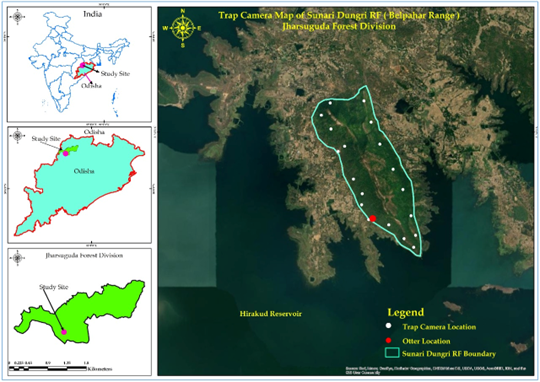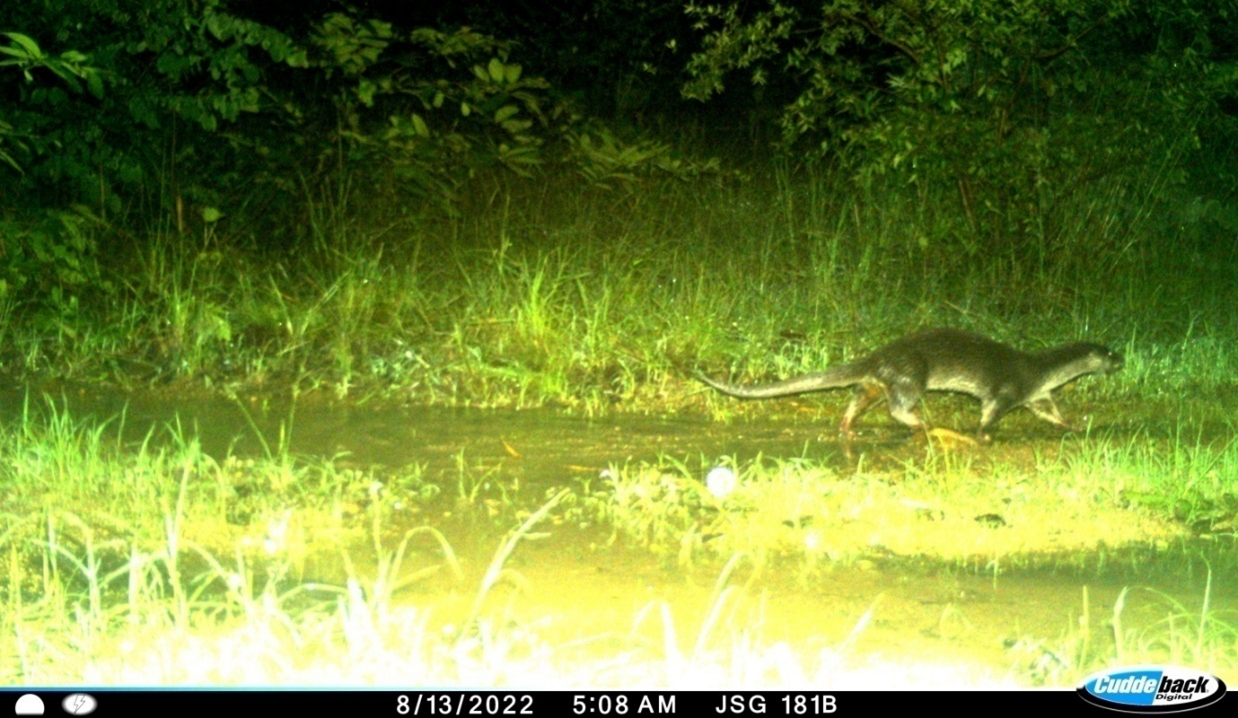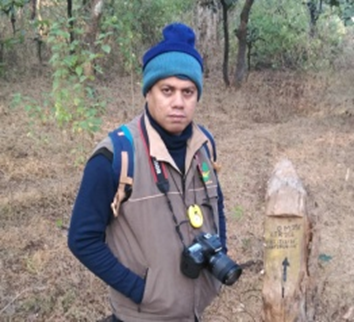IUCN/SSC Otter Specialist Group Bulletin

©IUCN/SCC Otter Specialist Group
Volume 40 Issue 4 (October 2023)
Citation: Palei, N.C., Rath, B.P., Patra, L.K., and Ghosh, B. (2023). First Photographic Records of Smooth-Coated Otter (Lutrogale perspicillata) in Jharsuguda Forest Division, Odisha, India. IUCN Otter Spec. Group Bull. 40 (4): 176 - 182
First Photographic Records of Smooth-Coated Otter (Lutrogale perspicillata) in Jharsuguda Forest Division, Odisha, India
Nimain Charan Palei1*, Bhakta Padarbinda Rath1, Lalit Kumar Patra2, and Biswajit Ghosh3*
1Office of the Principal Chief Conservator of Forests (Wildlife) & Chief Wildlife Warden, Odisha, India
2Divisional Forest Officer, Jharsuguda Forest Division, Jharsuguda, Odisha, India
3Office of the Divisional Forest Officer, Jharsuguda Forest Division, Jharsuguda, Odisha, India
*Corresponding Author Email: wildpalei@gmail.com
Received 5th May 2023, accepted 3rd June 2023
Abstract: The smooth-coated otter is an IUCN-Vulnerable species as a result of habitat loss and poaching. We deployed 15 camera traps, in two phases, in Jharsuguda Forest Division, on 8th June and 5th August 2022, with a total sampling effort of 750 trap days. Out of 1682 camera trap photographs, one photograph capture of smooth-coated otter was recorded, where there had previously been no smooth-coated otter records. This study presents a novel record of Smooth-coated otter Lutrogale perspicillata in Jharsuguda Forest Division, Odisha, India.
Keywords: Smooth-coated otter, camera trapping, Jharsuguda Forest Division, Odisha, India
INTRODUCTION
The smooth-coated otter (Lutrogale perspicillata, Geoffroy), a medium sized otter weighing between 7 and 11 kg (Prater, 2005) is distributed throughout southern Asia from Indonesia, through southeast Asia, and westwards through southern China, Pakistan and India, with an isolated population in Iraq (Pocock, 1941; Hussain, 1993; de Silva et al., 2015). In India, it is continuously distributed from the foothills of Himalayas southward to southern India occurring in major rivers and coastal areas (Prater, 2005; Hussain, 1993). Smooth-coated otter is a semi-aquatic social carnivore depending on wetland habitats and vulnerable to loss and degradation of habitat, since wetlands are currently among the most threatened and vanishing ecosystems worldwide (Davidson, 2014). Poaching for pelts, and retaliatory killing as a result of otter-human conflicts, are also threatening the survival of this species across its distribution range (de Silva et al., 2015). Therefore, it has been categorized as ‘Vulnerable’ in the IUCN Red List of Threatened Species (de Silva et al., 2015) and legally protected under Schedule-I of the Indian Wildlife (Protection) Act, 1972.
Out of thirteen extant species of otters found worldwide, India is home to three species, namely the Asian Small-Clawed Otter (Aonyx cinereus), the Smooth-Coated Otter (Lutrogale perspicillata) and the Eurasian Otter, Lutra lutra (Hussain, 1999). In India, the Asian Small-Clawed Otter is found from the Himalayan foothills of Himachal Pradesh to West Bengal, Northeast India, as well as in southern Indian hill ranges of Karnataka, Tamil Nadu and Kerala (Pocock, 1941; Hussain et al., 2011) and eastern India of Odisha (Mohapatra et al., 2014). The Smooth-Coated Otter is distributed throughout India from the Himalayas southwards, and has been reported from the north Indian states of Himachal Pradesh, Punjab, plains of Uttar Pradesh, Madhya Pradesh, Rajasthan, Bihar, in the central Indian plateau of Madhya Pradesh, Maharashtra, Goa, Andhra Pradesh, in the east and northeast in Odisha, West Bengal, Assam through Burma, in the south in Karnataka, Kerala, and Tamil Nadu (Prater, 1971; Hussain, 1999).
In Odisha, all three species of otters have previously been reported (Acharjyo, 1999; Mohapatra et al., 2014; Palei et al., 2020; Palei et al., 2022). The Smooth-Coated Otter’s distribution covers most parts of the Odisha, like Bhitarkanika Wildlife Sanctuary and Chilika Wildlife Sanctuary (Palei et al., 2020; Adhya and Dey, 2020). Here we provide the first record of the Smooth-Coated Otter in Jharsuguda Forest Division, western Odisha.
STUDY AREA
The Jharsuguda Forest Division is situated at Latitude 21.57º N to 22.01º N and longitude 83.42º E to 84.38º E. The Division is the northwestern part of the state of Odisha. The forest reserve is located in the southern part of the Jharsuguda Forest Division (Fig. 1) with an area of 392.71 ha (Sunari Dungri Reserve Forest). The mean daily temperature of winter ranges from 10 °C to 13 °C and that of summer from 30 °C to 47 °C. There are three distinct seasons: Summer - March to June, Rainy - July to October, and winter - November to February.

The rainfall of the Sanctuary and the nearby areas varies from 1000 mm to 1700mm. Due to good rainfall in the Division area, moist peninsular high-level Sal and moist mixed deciduous forests are found. Most local people in the RF are villagers, and their activities inside the forest are grazing livestock, and collection of forest products (e.g. fodder for livestock, non-timber). The Division is dominated by Northern Tropical Dry Deciduous Forest, Dry Peninsular Sal Forests and Northern Dry Mixed Deciduous Forests. (Champion and Seth, 1968). The Reserve Forest contain forest of good quality, with Terminalia tomentosa. Anogeissus latifolia. Pterocarpus marsupium, Diospyros melanoxylon, Adina cordifolia, Terminalia chebula, terminalia bellerica, lagerstroemia parviflora, Buchananialanzyn, Lanniacoromandelica and Dalbergia latifolia etc. The common plants are Emblica officinalis, Cassia fistula, Morinda tinctoria. Antidesma species, and Randia species. The undergrowth in these forests is a mixture of Flemingiachappar, Indigofera pulchela, Wordfordia fruticosa, Desmodium species, and Strobilanthes species. The common climbers are Bauhinia vahlii and Smilax species ,while Combretum decandrum occurs in valleys and ravines.
Camera trap surveys were carried out from 10th June 2022 to 7th July 2022. In the Sunadungri reserve forest, fifteen camera trap stations were established in the study area. We selected the most suitable camera trap locations, along animal trails, forest roads and near creeks, based on preliminary sign surveys. At each camera trap station, a pair of automated motion-triggered digital camera-traps (Cuddeback Model C1; Non Typical, Inc., Green Bay, WI) were placed on either sides of the location, strapped to trees, facing each other, around 45-50 cm above the ground, using no lure or bait. All cameras were operational 24 hours per day, and programmed to delay sequential photographs by 30 s recording time. Cameras were checked every week to replace the batteries and memory cards and to ensure their proper functioning. Total sampling effort was calculated as the sum of the effective days across all stations where both cameras were functioning (Boitani and Powell, 2012). Each photograph was manually checked to identify the species. Date, time, and temperature were noted for each identified species. We considered photos separated by at least 30 minutes as independent events (Ohashi et al., 2013; Guo et al. 2017).
RESULTS
From 10th June 2022 to 7th July 2022, we had fifteen locations covering an area of 392.71sq km2 in the Sunaridungri Reserve Forest in Jharsuguda Forest Division (Fig. 2), a total effort of 450 trap nights, capturing thirteen mammal species, including Smooth-Coated Otter. The Smooth-Coated Otter was first recorded in a camera trap on 13th August 2022 (Fig. 3) in Sunadungri Reserve Forest. This is the first record of this species in Jharsuguda Forest Division.


In addition to Smooth coated otters, the other mammalian species recorded during the camera trap survey were leopard (Panthera pardus), rusty spotted cat (Prionailurus rubiginosus), jungle cat (Felis chaus), striped hyena (Hyaena hyaena), golden jackal (Canis aureus), Indian fox (Vulpes bengalensis), sloth bear (Melursus ursinus), honey badger (Mellivera capensis), barking deer (Muntiacus muntjak), wild pig (Sus scrofa), four-horned antelope (Tertracerus quadricornis), and hanuman langur (Semnopithecus entellus).
DISCUSSION
As far as we are aware, this is the first photographic record from a camera trap of the smooth-coated otter (Lutrogale perspicillata) in Jharsuguda Forest Division. To our surprise, only one image of a single individual was captured during the whole camera trap survey. The camera trap was installed adjacent to the Hirakud Reservoir. The smooth-coated otter’s distribution covers most eastern parts of Odisha, including Bhitarkanika Wildlife Sanctuary and Chilika Wildlife Sanctuary (Palei et al., 2020; Adhya and Dey, 2020). The distribution of smooth coated otters in western Odisha seems very scanty. No further camera trap captures or indirect signs were recorded in western Odisha. Our study should be considered only as preliminary results, however. It represents an important contribution towards increasing our knowledge of the Smooth-coated otter. Further detailed research should, therefore, be focused on the otter in the study area in order to have better understanding of the ecology of the species. This information will help generate a more effective conservation and management of the species.
Acknowledgements: We are thankful to the Principal Chief Conservator of Forest (Wildlife) and Chief Wildlife Wardens, Odisha for support in carrying out the study. We are also thankful to Divisional Forest Officer, Jharsuguda Forest Division, Jharsuguda and Range Officer, Belapahad Forest Range and his staff for their unfailing extended help during the fieldwork.
REFERENCES
Acharjyo, L.N. (1999). Status of Mustelids, Viverrids and Herpestids of Orissa. In: Envis Bulletin on Wildlife and Protected Areas. Hussain, S.A. (Eds) WII, Dehradun, 2: 62–64.
Adhya, T., Dey, P. (2020). First record of Eurasian otter (Lutra lutra) from Chilika lagoon: a Ramsar site situated on the East coast of India. OTTER: the Journal of the International Otter Survival Fund, 6: 49-55. https://www.otter.org/documents/journals/IOSF_Journal_Vol6_2020.pdf
Boitani, L., Powell, R.A. (2012). Carnivore ecology and conservation: a handbook of techniques. Oxford University Press.
Champion, H.G. and Seth, S.K. (1968). A Revised Forest Types of India. Manager of Publications, Government of India, Delhi.
Datta, A., Anand, M.O., Naniwadekar, R. (2008). Empty forests: Large carnivore and prey abundance in Namdapha National Park, north-east India. Biological Conservation, 141: 1429–1435. https://doi.org/10.1016/j.biocon.2008.02.022
Davidson, N.C. (2014). How Much Wetlands has the World Lost? Long-term and Recent Trends in Global Wetland Area. Marine and Freshwater Research, 65(10): 934–941. http://dx.doi.org/10.1071/MF14173
de Silva, P., Khan, W.A., Kanchanasaka, B., Reza Lubis, I., Feeroz, M.M., Al-Sheikhly, O.F. (2015). Lutrogale perspicillata. The IUCN Red List of Threatened Species 2015: e.T12427A21934884. Downloaded on 19 February 2020.
Debata S., Palei H.S., Mohapatra P.P., Palita S.K. (2015). Additional Records of Cantor’s Leaf-Nosed Bat Hipposideros galeritus Cantor, 1846 (Mammalia: Chiroptera: Hipposideridae) in Eastern India: Odisha. Journal of Threatened Taxa, 7(8): 7477–7479. https://doi.org/10.11609/JoTT.o4247.7477-9
Debata S., Swain K. K. (2018). Estimating mammalian diversity and relative abundance using camera traps in a tropical deciduous forest of Kuldiha Wildlife Sanctuary, eastern India. Mammal Study, 43: 45–53. https://doi.org/10.3106/ms2017-0078
Debata, S., Kar, T., Swain, K.K., Palei, H.S. (2018). The vulnerable Indian Skimmer Rynchops albicollis Swainson, 1838 (Aves: Charadriiformes: Laridae) breeding in Odisha, eastern India. Journal of Threatened Taxa, 9: 10961–10963. https://doi.org/10.11609/jott.3445.9.11.10961-10963
Gopi, G.V., Pandav, B. (2007). Avifauna of Bhitarkanika Mangroves, India. Zoos’ Print Journal, 22(10): 2839–2847. https://www.zoosprint.zooreach.org/index.php/zpj/article/view/7016
Guo, W., Cao, G., Quan, R-C. (2017). Population dynamics and space use of wild boar in a tropical forest, Southwest China. Global Ecology & Conservation, 11: 115–124. https://doi.org/10.1016/j.gecco.2017.04.005
Hussain, S.A. (1993). Aspects of the ecology of smooth-coated otters Lutra perspicillata in National Chambal Sanctuary. Unpublished Ph.D Thesis. Centre for Wildlife and Ornithology. Aligarh Muslim University. Aligarh, India.
Hussain, S.A. (1999). Status of otter conservation in India. Envis Bulletin: Wildlife and Protected Areas, 2 (2): 92-97.
Hussain, S.A., Gupta, S.K. and de Silva, P.K. (2011). Biology and Ecology of Asian Small-Clawed Otter Aonyx cinereus (Illiger, 1815): A Review. IUCN Otter Spec. Group Bull. 28 (2): 63 – 75 https://www.iucnosgbull.org/Volume28/Hussain_et_al_2011.html
Hussain, S.A. (2013). Activity pattern, behavioural activity and interspecific interaction of smooth-coated otter (Lutrogale perspicillata) in National Chambal Sanctuary, India. IUCN Otter Specialist Group Bulletin, 30(1): 5–17. https://www.iucnosgbull.org/Volume30/Hussain_2013.html
Karanth, K.U., Nichols, J.D. (1998). Estimation of tiger densities in India using photographic captures and recaptures. Ecology, 79: 2852–2862. https://doi.org/10.1890/0012-9658(1998)079[2852:EOTDII]2.0.CO;2
Kruuk, H. (2006). Otters: ecology, behaviour, and conservation. Oxford University Press Inc., New York. https://doi.org/10.1093/acprof:oso/9780198565871.001.0001
Martin, D.J., Mcmillan, B.R., Erb, J.D., Gorman, T.A., Walsh, D.P. (2010). Diel activity patterns of river otters (Lontra canadensis) in south-eastern Minnesota. Journal of Mammalogy, 91(5): 1213-1224. https://doi.org/10.1644/09-MAMM-A-083.1
Mishra, S.R., Mohan, M., Pati, J.D. (2018). First Photographic Documentation and Distribution of the Smooth-Coated Otter Lutrogale perspicillata in Similipal Tiger Reserve, Odisha, India. IUCN Otter Specialist Group Bulletin, 35(4): 186–192 https://www.iucnosgbull.org/Volume35/Mishra_et_al_2018.html
Mohapatra, P. P., Palei, H.S., and Hussain, S.A. (2014). Occurrence of Asian Small-Clawed Otter Aonyx cinereous (Illiger, 1815) in Eastern India. Current Science, 107(3): 367–370. https://www.currentscience.ac.in/Volumes/107/03/0367.pdf
O’Brien, T.G., Kinnaird, M.F., Wibisono, H.T. (2003). Crouching tigers, hidden prey: Sumatran tiger and prey populations in a tropical forest landscape. Animal Conservation, 6 (2): 131–139. https://doi.org/10.1017/S1367943003003172
Ohashi, H., Saito, M., Horie, R., Tsunoda, H., Noba, H., Ishii, H., et al. (2013). Differences in the activity pattern of the wild boar Sus scrofa related to human disturbance. European Journal of Wildlife Research, 59: 167–177. https://doi.org/10.1007/s10344-012-0661-z
Palei, H.S., Das U.P., Debata S. (2018a). The vulnerable fishing cat Prionailurus viverrinusin Odisha, eastern India: status and conservation implications. Zoology and Ecology, 28(2): 69–74. https://doi.org/10.1080/21658005.2018.1468646
Palei, H.S., Palei, N.C., Rath, B.P., Mishra, A.K. (2019a). Records of the globally threatened rusty-spotted cat in Odisha, India. Nature Conservation Research, 4(3): 112–116. https://dx.doi.org/10.24189/ncr.2019.053
Palei, H.S., Pradhan, T., Sahu, H.K. and Nayak, A.K. (2015). Estimating mammalian abundance using camera traps in the tropical forest of Similipal Tiger Reserve, Odisha, India. Proceedings of the Zoological Society, 69: 181–188. https://doi.org/10.1007/s12595-015-0143-x
Palei, N.C., Rath B.P., Palei H.S., Mishra A.K. (2018b). Occurrence of melanistic leopard in Odisha, eastern India. Cat News, 68: 7–8.
Palei, N.C., Rath, B.P., Palei, H.S., Mishra, A.K. (2019b). Photographic evidences of Indian grey wolf (Canis lupus pallipes) in Sundargarh forest division, Odisha, India. e-planet, 17(2): 152-156. https://e-planet.co.in/images/Publication/vol17_2/photographic.pdf
Palei, N.C., Rath, B.P., Palei, H.S. and Acharya, B.P. (2020). Population Status and Activity Pattern of Smooth-Coated Otter (Lutrogale perspicillata) in Bhitarkanika National Park, Odisha, Eastern India IUCN Otter Spec. Group Bull. 37 (4): 205 - 211 https://www.iucnosgbull.org/Volume37/Palei_et_al_2020.html
Palei, N.C., Palei, H.S., Rath, s., Rath, B.P., and Mishra, A.K. (2022). Photographic Record of Eurasian Otter Lutra lutra (Linnaeus, 1758) in Odisha, India. IUCN Otter Spec. Group Bull. 39 (2): 102 – 109. https://www.iucnosgbull.org/Volume39/Palei_et_al_2022.html
Pocock, R.I. (1941). The fauna of British India, including Ceylon and Burma. Volume 2, Mammals, pp. 265–317. Taylor and Francis, London.
Prater, H.S. (2005). The Book of Indian Animals. New Delhi: Oxford University Press.
R Development Core Team. (2019). R: A Language and Environment for Statistical Computing. Vienna, Austria: R Foundation for Statistical Computing. https://www.r-project.org/ .
Ridout, M.S., Linkie, M. (2009). Estimating overlap of daily activity patterns from camera trap data. Journal of Agricultural Biological and Environmental Statistics, 14: 322–337. https://doi.org/10.1198/jabes.2009.08038
Rovero, F., Marshall, A.R. (2008). Camera trapping photographic rate as an index of density in forest ungulates. Journal of Applied Ecology, 46: 1011–1017. https://doi.org/10.1111/j.1365-2664.2009.01705.x
Venkatraman, C., Padmanaban, P., Shrinivaasu, S., Sivaleela, G. (2016). Faunal diversity of Bhitarkanika mangroves, Odisha. Records of the Zoological Survey of India, 116(4): 407–430. https://doi.org/10.26515/rzsi/v116/i4/2016/117827
Premiers Enregistrements Photographiques de la Loutre à Pelage Lisse (Lutrogale perspicillata) dans la Division Forestière de Jharsuguda, à Odisha, en Inde
La loutre à pelage lisse est une espèce vulnérable selon l’UICN en raison de la perte d’habitat et du braconnage. Nous avons déployé 15 pièges photographiques en deux phases dans la division forestière de Jharsuguda, les 8 juin et 5 août 2022, avec un effort d’échantillonnage total de 750 jours de piégeage. Sur 1.682 photos de pièges photographiques, nous avons enregistré une capture photographique de loutre à pelage lisse dans la division forestière de Jharsuguda, alors qu’auparavant, il n’y avait aucun enregistrement de loutre à pelage lisse dans cette division. Cette étude présente la première observation de loutre à pelage lisse Lutrogale perspicillata dans la division forestière de Jharsuguda, à Odisha, en Inde.
Revenez au dessus
Resumen: Primeros Registros Fotográficos de Nutria Lisa (Lutrogale perspicillata) en la División Forestal Jharsuguda, Odisha, India
La nutria lisa es una especie Vulnerable (UICN) como resultado de la pérdida de hábitat y la caza ilegal. Desplegamos 15 cámaras-trampa en dos fases (8 de Junio y 5 de Agosto de 2022) en la División Forestal Jharsuguda, con un esfuerzo muestral de 750 días-trampa. De un total de 1.682 fotografías, fue registrada una captura fotográfica de una nutria lisa en la División Forestal Jharsuguda, pero no había registros previos de nutria lisa en ésta División. Este estudio presenta el primer registro de nutria lisa Lutrogale perspicillata en la División Forestal Jharsuguda, Odisha, India.
Vuelva a la tapa
ସାରାଂଶ
ଝାରସୁଗୁଡ଼ା ବନଖଣ୍ଡରେ ନରମ ଆବରଣ ବିଶିଷ୍ଟ (ସ୍ମୁଥ୍ କୋଟେଡ) ଓଧ (Lutrogale perspicillata) ର ସର୍ବକାଳୀନ ପ୍ରଥମ ଫୋଟୋଗ୍ରାଫିକ ରେକର୍ଡ଼, ଓଡିଶା, ଭାରତ।
ବାସସ୍ଥଳୀ କ୍ଷୟ ଏବଂ ଶିକାର କାରଣରୁ ନରମ ଆବରଣ ବିଶିଷ୍ଟ (ସ୍ମୁଥ୍ କୋଟେଡ) ଓଧ ଆଇୟୁସିଏନ୍-ବିପଦପ୍ରବଣ ପ୍ରାଣୀ ଭାବେ ପରିଗଣିତ। ଝାରସୁଗୁଡ଼ା ବନଖଣ୍ଡରେ ଦୁଇଗୋଟି ପର୍ଯ୍ୟାୟରେ ଆମେ ୮ ଜୁନ ଏବଂ ୫ ଅଗଷ୍ଟ ୨୦୨୨ ରିଖରେ ୧୫ ଗୋଟି କ୍ୟାମେରା ଟ୍ରାପ ନିୟୋଜନ କରିଥିଲୁ ଯେଉଁଥିରେ ମୋଟ ୭୫୦ ଟ୍ରାପ ଦିନର ନମୁନା ସଂଗ୍ରହ ପ୍ରୟାସ କରାଯାଇଥିଲା। ମୋଟ ୧୬୮୨ଟି କ୍ୟାମେରା ଟ୍ରାପ ଫୋଟୋ ମଧ୍ୟରୁ ଗୋଟିଏ ଫୋଟୋ ନରମ ଆବରଣ ବିଶିଷ୍ଟ (ସ୍ମୁଥ୍ କୋଟେଡ) ଓଧ ଝାରସୁଗୁଡ଼ା ବନଖଣ୍ଡରୁ ରେକର୍ଡ଼ କରାଯାଇଥିଲା; କିନ୍ତୁ ପୂର୍ବରୁ ଝାରସୁଗୁଡ଼ା ବନଖଣ୍ଡରୁ ନରମ ଆବରଣ ବିଶିଷ୍ଟ (ସ୍ମୁଥ୍ କୋଟେଡ) ଓଧ ଉପସ୍ଥିତିର କୌଣସି ରେକର୍ଡ଼ ଉପଲବ୍ଧ ନଥିଲା। ଏହି ଅଧ୍ୟୟନ ଝାରସୁଗୁଡ଼ା ବନଖଣ୍ଡ, ଓଡିଶା, ଭାରତରେ ନରମ ଆବରଣ ବିଶିଷ୍ଟ (ସ୍ମୁଥ୍ କୋଟେଡ) ଓଧ (Lutrogale perspicillata)ରସର୍ବକାଳୀନପ୍ରଥମରେକର୍ଡ଼ଉପସ୍ଥାପନକରୁଅଛି।
ଆରମ୍ଭକୁ ଫେରନ୍ତୁ |



